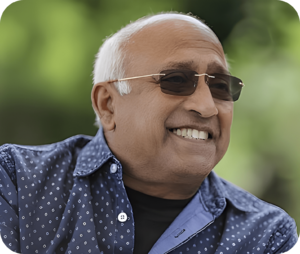Rakesh Sharma facts for kids
Quick facts for kids
Wing Commander
Rakesh Sharma
|
|
|---|---|

Sharma in 2018
|
|
| Born | 13 January 1949 |
| Status | Retired |
| Alma mater | National Defence Academy Air Force Academy |
| Occupation | Fighter pilot at IAF Research Cosmonaut at ISRO Test pilot at HAL |
| Space career | |
| Indian cosmonaut | |
|
Time in space
|
7 days, 21 hours, 40 minutes |
| Selection | 1982 Intercosmos (India) |
| Missions | Soyuz T-11/T-10 |
|
Mission insignia
|
|
| Military career | |
| Allegiance | |
| Service/ |
|
| Years of service | 1970 – 1990 |
| Rank | |
| Service number | 12396 F(P) |
| Battles/wars | 1971 Indo-Pakistani War |
| Awards | |
| Spouse(s) | Madhu Sharma |
| Children | 2 |
Wing Commander Rakesh Sharma is a famous Indian cosmonaut and a former officer in the Indian Air Force. He made history on April 3, 1984, when he became the first Indian citizen to travel into space. He flew on a Soviet spacecraft called Soyuz T-11 as part of a special space program.
Contents
Early Life and Military Start
Rakesh Sharma was born on January 13, 1949, in Patiala, which is now in Punjab, India. He went to school in Hyderabad and later studied at Nizam College.
In July 1966, he joined the National Defence Academy to train for the air force. By 1970, he became a pilot in the Indian Air Force. He flew 21 combat missions during the 1971 war between India and Pakistan.
Career Highlights
Becoming an Air Force Pilot
After joining the Indian Air Force in 1970, Rakesh Sharma became a test pilot. This means he flew new or repaired aircraft to make sure they worked correctly. By 1984, he had risen to the rank of squadron leader.
Journey to Space
On September 20, 1982, Rakesh Sharma was chosen for an amazing mission. He was selected to become a cosmonaut and travel to space. This was part of a joint program between the Indian Air Force and the Soviet Union's space program.
In 1984, Rakesh Sharma became the first Indian citizen to go into space. He launched aboard the Soviet rocket Soyuz T-11 from the Baikonur Cosmodrome on April 3, 1984. His spacecraft connected with the Salyut 7 Orbital Station.
Sharma spent 7 days, 21 hours, and 40 minutes aboard the Salyut 7 space station. During his time there, he and his team performed many scientific experiments. These studies focused on how the human body reacts to space and how to observe Earth from orbit.
While in space, Sharma had a special video call with officials in Moscow and the then-Prime Minister of India, Indira Gandhi. When she asked him how India looked from space, he famously replied, "Sare Jahan Se Accha" (meaning "better than the whole world"). This is a line from a famous patriotic poem. With his journey, India became the 14th country to send a person into space.
After Space Travel
After his space mission, Rakesh Sharma retired from the Air Force as a wing commander. In 1987, he joined Hindustan Aeronautics Limited (HAL), a big Indian aerospace company. He worked there as a chief test pilot until he retired from flying in 2001.
Awards and Honors
Rakesh Sharma received several important awards for his bravery and achievements. When he returned from space, he was given the honor of the Hero of the Soviet Union. He is still the only Indian to have received this award.
India also honored him with its highest peacetime gallantry award, the 'Ashoka Chakra'. The two Soviet members of his mission, Yury Malyshev and Gennadi Strekalov, also received this award.
The Ashoka Chakra is given for showing great courage and daring. Rakesh Sharma was recognized for volunteering for the challenging space mission and for his excellent work during his time in orbit. He brought great pride to India.
Personal Life
Rakesh Sharma is married to Madhu. They have two children: a son named Kapil, who is a film director, and a daughter named Krittika, who is a media artist.
See also
 In Spanish: Rakesh Sharma para niños
In Spanish: Rakesh Sharma para niños
- Gaganyaan
- Kalpana Chawla
- Sirisha Bandla
- Ravish Malhotra
- P. Radhakrishnan
- Shubhanshu Shukla


